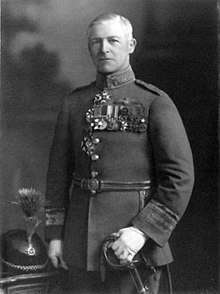Charles Laverock Lambe
Air Vice Marshal Sir Charles Laverock Lambe, KCB, CMG, DSO (10 May 1875 – 25 April 1953) was a distinguished officer in the Royal Navy and a foundational commander in the Royal Air Force (RAF) on its creation in 1918. Lambe was one of the most senior officers with naval experience to serve in the 1920s RAF.
Sir Charles Laverock Lambe | |
|---|---|
 Air Vice Marshal Lambe | |
| Born | 10 May 1875 |
| Died | 25 April 1953 (aged 77) |
| Allegiance | United Kingdom |
| Service/ | Royal Navy (1891–1918) Royal Air Force (1918–31) |
| Years of service | 1891–1931 |
| Rank | Air Vice Marshal |
| Commands held | Coastal Area (1928–31) RAF Halton (1924–28) No. 1 School of Technical Training (1924–28) Midland Area (1919) No. 5 Group (1918–19) VII Brigade RAF (1918) RNAS Dover Command (1916–18) No. 5 Squadron RNAS (1915) HMS Hermes (1914–15) |
| Battles/wars | Benin Expedition of 1897 First World War |
| Awards | Knight Commander of the Order of the Bath Companion of the Order of St Michael and St George Distinguished Service Order Mentioned in Despatches Officer of the Legion of Honour (France) Croix de guerre (France) Commander of the Order of Leopold (Belgium) Knight of the Order of the Crown (Belgium) Croix de guerre (Belgium) Navy Distinguished Service Medal (United States)[1] |
Biography
Joining the Royal Navy in or before 1891, Lambe attended the Britannia Naval College. In 1897 he was promoted to lieutenant and served aboard HMS Magpie, taking part in Rear Admiral Rawson's punitive expedition to Benin. Lambe later served at the Naval Ordnance Department. He gained a promotion to commander in 1908 and was appointed Assistant Director of Naval Ordnance and Torpedoes in 1913.
In August 1914, Lambe was appointed as captain of the seaplane carrier HMS Hermes, which sank after being torpedoed in October of the same year. At the start of August 1916, having just been promoted to wing captain, Lambe took up appointment as the officer commanding the Royal Naval Air Service's Dover Command which included RNAS units at Dunkirk. During his time at the Dover Command, Lambe's aircraft carried out bombing raids on the German submarine harbours at Bruges.[2] On 1 April 1918, Lambe was appointed General Officer Commanding the VII Brigade of the RAF. On 23 April, Lambe's VII Brigade carried out air attacks as part of the blocking of Zeebrugge and Ostend.[3] On 9 May, Lambe was once again the air commander in a naval action, this time for the Second Ostend Raid.[4]
In 1919 Lambe was selected by Sir Hugh Trenchard to sit on the Air Council and in 1924 he was appointed commandant of the RAF's No. 1 School of Technical Training. In 1928 Lambe was appointed Air Officer Commanding Coastal Area (the forerunner of Coastal Command) from where he retired in the rank of air vice marshal in 1931. Lambe died on 25 April 1953.
References
- "No. 31691". The London Gazette (Supplement). 16 December 1919. p. 15614.
- Jellicoe, John, Admiral of the Fleet, 1st Earl Jellicoe (1920). The crisis of the naval war. pp. 72, 73.
- "AIRCRAFT in the ZEEBRUGGE AND OSTEND BATTLES". Flight. The Royal Aero Club of the U.K. 27 February 1919. Retrieved 4 July 2011.
- "No. 30870". The London Gazette (Supplement). 27 August 1918. p. 10088.
External links
| Military offices | ||
|---|---|---|
| Preceded by Unknown |
Officer Commanding RNAS Dover Command 1916–1918 |
Command disbanded Responsibilities transferred to VII Brigade |
| Vacant Title last held by Tom Webb-BowenOn 26 March 1918 (Italian operations) |
General Officer Commanding VII Brigade (Dover and Dunkirk operations) April – May 1918 |
Brigade disbanded Responsibilities transferred to No. 5 (Operations) Group |
| Preceded by Frederick Halahan As Officer Commanding |
General Officer Commanding No. 5 (Operations) Group 1918–1919 |
Vacant Title next held by William CallawayIn 1937 As Air Officer Commanding |
| Preceded by John Higgins |
General Officer Commanding Midland Area January – February 1919 |
Succeeded by Bertram Cooke |
| Preceded by Unknown or none |
Director of Equipment 1919–1922 |
Succeeded by Duncan Pitcher |
| Preceded by Francis Scarlett |
Commandant, No. 1 School of Technical Training 1924–1928 |
Succeeded by Ian Bonham-Carter |
| Preceded by Francis Scarlett |
Air Officer Commanding Coastal Area 1928–1931 |
Succeeded by Robert Clark-Hall |